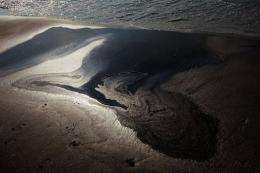Obama visits oil spill zone, 'top kill' results awaited

US President Barack Obama arrived in Louisiana Friday to view the oil spill response amid suspense over the latest bid to cap the massive leak in the Gulf of Mexico.
A day after he pledged to take responsibility for stopping and cleaning up the disastrous spill, Obama was in the region for his second visit to assess the situation.
Meanwhile, a US official cited progress in BP's efforts to plug the leak, but the energy giant warned it would take two days to determine the measure's success.
"My job is to get this fixed," a visibly angered Obama said Thursday at his first formal White House press conference in 10 months, called specifically to address the spill.
Initial indications were positive from BP's latest attempt to plug the leak, a so-called "top kill" process that floods the leak with heavy drilling fluid, according to Admiral Thad Allen, the former Coast Guard commandant charged with overseeing the oil spill response.
"They have been able to push the hydrocarbons down with the mud. The real challenge is to put enough into the well to keep the pressure where the can put a cement plug over the top," he said on ABC's "Good Morning America."
But BP warned it would be two days before the results were clear.
"I think it's probably at least 48 hours away before we could have confidence that we succeeded," BP chief executive Tony Hayward said.
He added that BP, which leased the Deepwater Horizon rig that unleashed the spill when it sank on April 22, two days after an explosion that killed 11 rig workers, was also trying a second method dubbed the "junk shot."
The process involves inserting assorted debris into the leak to assist the plugging process.
But even if that works, new government data showed Thursday that up to 30 million gallons of oil are clogging the waters of the Gulf of Mexico, almost triple the amount spilled in Alaska's 1989 Exxon Valdez disaster.
Amid the environmental catastrophe, there also were growing fears for the health of cleanup workers exposed to the crude and chemical dispersants, some of whom had to be airlifted for treatment after falling sick while out at sea.
The British energy giant said Friday the oil spill had cost the firm about 930 million dollars, while BP's market value has also dropped by billions.
BP said Thursday it had paused the top kill process to allow engineers to keep checking pressure as robotic submarines fed the drilling fluid into the leak.
"Nothing's actually gone wrong or unanticipated," BP chief operations officer Doug Suttles said at a press conference on the latest bid to cap the ruptured pipe on the seabed nearly a mile (1,600 meters) below the surface.
The firm came in for harsh criticism from Obama Thursday, who also slammed past lax regulation and announced steps to ban new deepwater oil exploration for six months and suspend some permits and lease sales off the vulnerable coasts of Alaska and Virginia.
"In this instance, the oil industry's cozy and sometimes corrupt relationship with government regulators meant little or no regulation at all," he said.
He suggested BP may have sought to downplay the true extent of the economic and ecological disaster now threatening Louisiana, Alabama, Mississippi and Florida as government data showed the oil may have been flowing up to four times faster than previous estimates.
The new estimates put the flow rate at 12,000 to 19,000 barrels (504,000 to 798,000 gallons) a day -- much higher than the previous estimate of 5,000 barrels.
That would mean between 18.6 million gallons and 29.5 million gallons of oil have poured into the Gulf -- far more than the roughly 11 million gallons of crude spilled in Valdez disaster.
Obama dismissed charges the government response had been too slow, but said it was legitimate to question whether BP was "being fully forthcoming about the extent of the damage."
Meanwhile all 125 commercial fishing boats helping to clean up the oil off Louisiana were recalled after seven workers reported health problems.
The cause of the workers' illnesses is under investigation, said BP's Suttles, as he sought to calm public fears over the chemical dispersant used to break down the oil for faster decomposition in the water.
"As I've stated many times, if there is a less toxic, more effective product (than Corexit), we'll switch to it, without a doubt," he said.
(c) 2010 AFP



















